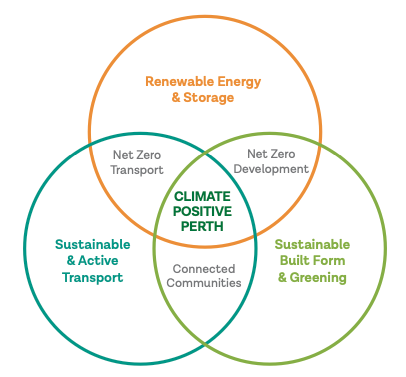(Research) Climate Positive Perth
(Consultation Draft)
A vision for a low carbon,
connected & liveable city
“Two-thirds of us will be living in urban areas by 2050. Despite taking up just 2 per cent of global landmass, our urban centres consume more than 75 per cent of natural resources, are responsible for over 50 per cent of solid waste and emit up to 60 per cent of greenhouse gases, contributing to pollution, climate change and biodiversity loss.”
– Ellen MacArthur Foundation

Each topic examined in Climate Positive Perth intersects with each other (Source: Climate Positive Perth)
Climate Positive Perth aims to provide a roadmap to mitigate the impacts of climate change, reduce emissions and sustainably accommodate a population of 3.5 million people by 2050, in the city of Perth.
Designing the city's future as a community-based process, Nic Brunsdon has contributed as a member of the roundtable and consultant for the development of Chapter two of this report: Planning and Built Form.
The chapter outlines city density as one of the main points. Focusing around transit, Perth can become a walkable city where growth is accommodated in existing suburbs, limiting urban sprawl and meeting high-quality infill targets.
Envisioning a compact city considers thoughtful density, as well as a polycentric planning and development. More liveable and connected centres and neighbourhoods are easier to decarbonise and will be places with a diverse mix of uses alongside a mix of housing types and sizes, and activated corridors. Taking as a model the 20-minute neighbourhood, people can meet most of their everyday needs within a 20-minute walk, cycle or local public transport trip of their home.
A transformation that activates the desire for 'living locally,' diversifying housing options, and bringing social and health benefits, while defining urban growth boundaries.
Net-zero energy standards are the third aspect presented in the chapter. This includes requirements for cleaner energy and high-quality insulation for new housing, as well as the retrofitting of insulation in existing buildings to provide energy savings and support low-income housing.
The described areas are part of a transition to a low-carbon and more sustainable city, including Nature and Community Positive Initiatives. Following an interconnectedness approach, the city of Perth will be enhanced through the reduction of urban sprawl, revitalizing our communities, and creating better connections to the environment.
[October 2023]